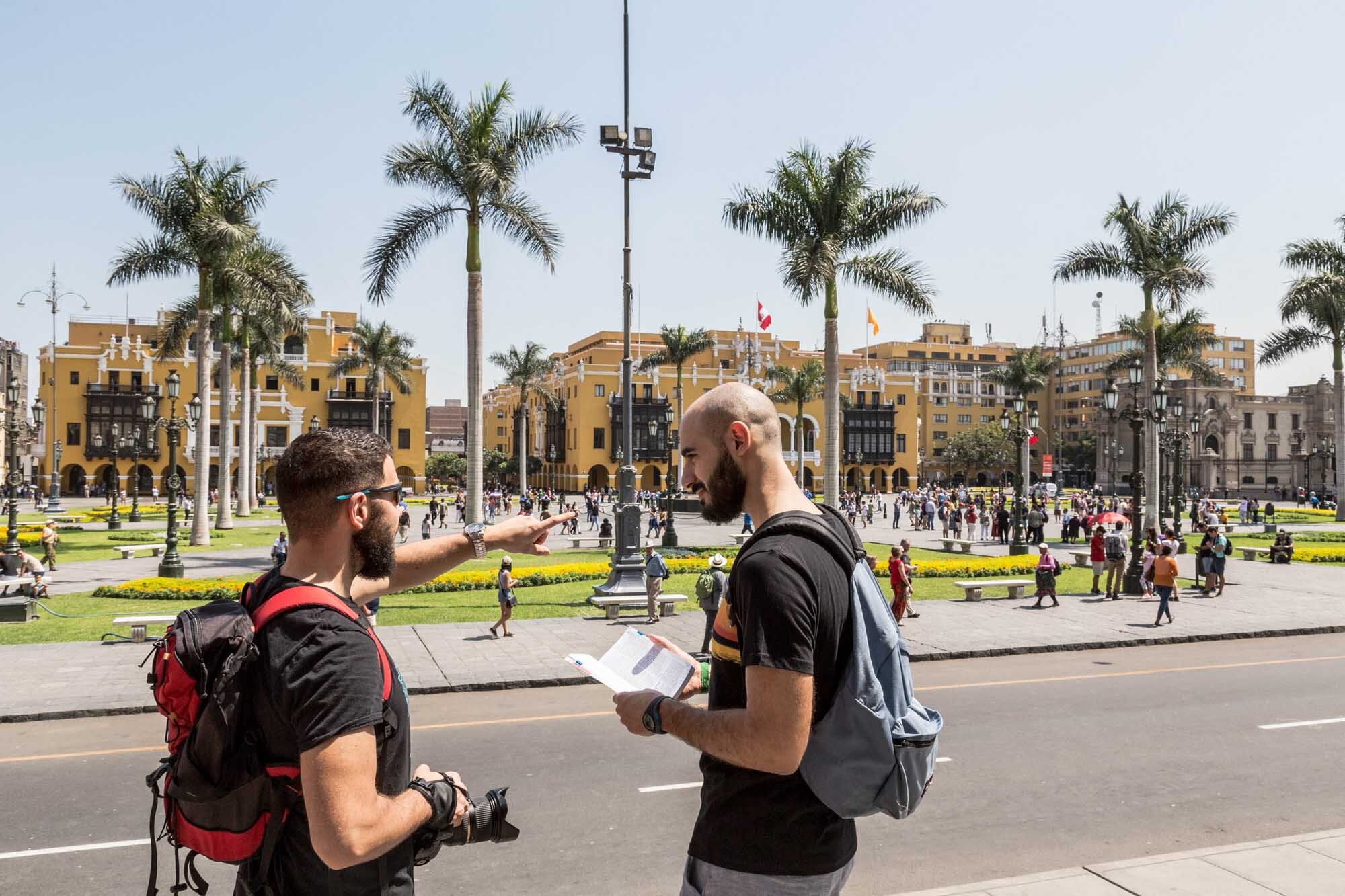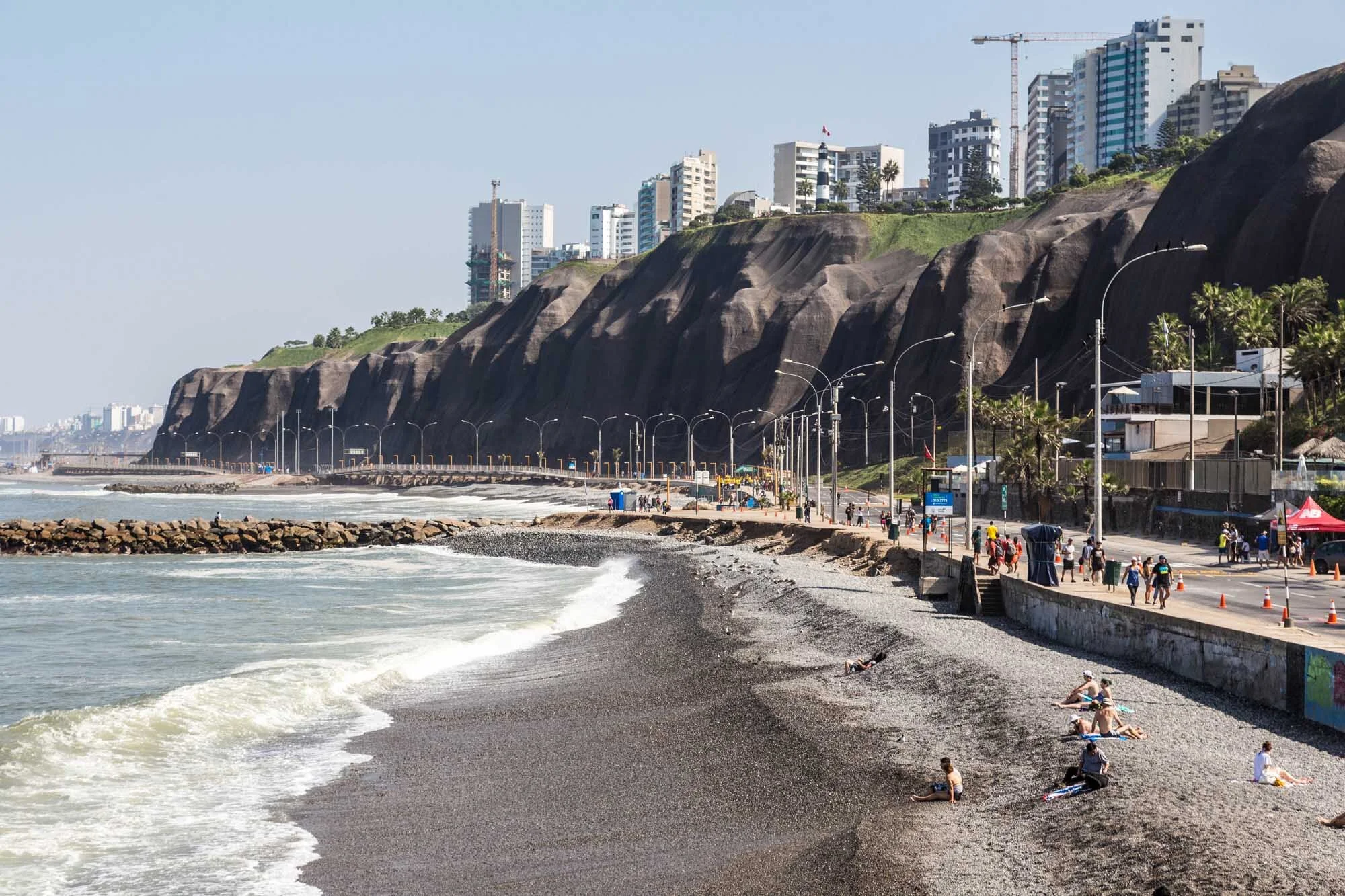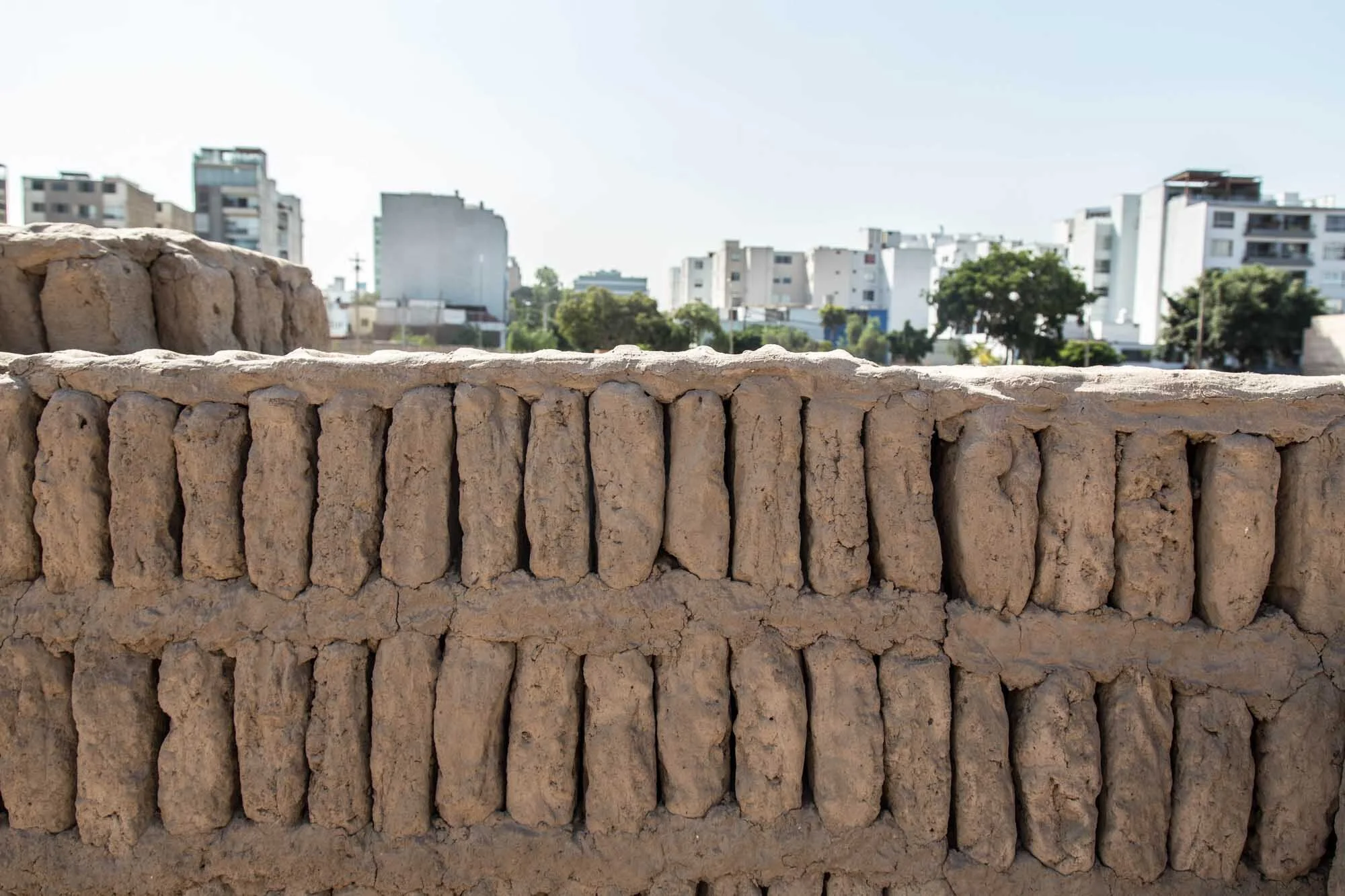
LIMA
What to do in Lima in three days.
World-famous cuisine, ancient ruins and a breathtaking coastline.
In your trip to Peru, you might be tempted to skip the gigantic Lima in favour of beautiful exotic destinations, such as Titicaca Lake or Machu Picchu.
But that would be a mistake.
Indeed, Lima is one of the largest cities in South America and it’s congested and chaotic, but it’s also fascinating and fun, if you know where to go and what to eat.
Lima boosts a spectacular coastline, a compact city centre, an intriguing food scene, archaeological sites, museums and shopping centres.
The city expanded rapidly in the last century.
In this unorganised growth, Lima absorbed splendid huacas (pre-Inca ruins), pueblos jovenes (“young villages”, or shantytowns) and wealthy enclaves. The result of this expansion is that nowadays glass skyscrapers, ancient ruins and derelict buildings are elbow-to-elbow, competing for the sunlight.
Its 9 millions inhabitants (called Limaq) learned how to deal with the morning fog and the heat in summer, and with the humidity and the persistent low-clouds in winter.
We recommend spending a couple of days in Lima to enjoy its diversity and contrasts, a perfect introduction to Peru and South America.
RECAP & ITINERARY
When? April. How long? 3 days. Temperature? Mostly sunny with a few clouds. The ocean was chilly but acceptable. Budget? 250-300€ per person all inclusive. Planning needed? Moderate. Accommodation? Hostel Kokopelli. What to book in advance? None.
***
Day 1 // Land in Lima / Dinner at Costanera 700
Day 2 // Surf at Waikiki Beach / Parque del Amor / Sunset at La Herradura viewpoint
Day 3 // Explore downtown Lima / Plaza de Armas / Catacombs of San Francisco Monastery
Day 4 // Huaca Pucclana / Late afternoon flight to Arequipa
LIMA BY THE DISTRICTS
Downtown Lima: the UNESCO-protected historic centre with nice examples of colonial architecture, Plaza de Armas, the catacombs in San Francisco Monastery, museums, the Hotel Bolivar in Plaza San Martin and the Water Fountain Park.
Miraflores: the go-to district with all you need from hotels, top restaurants, shopping and nightlife to parks and archaeological sites.
Barranco: a slightly southern district, a sort of bohemian and artistic hotspot with a lively nightlife.
San Isidro: an upscale business district with large avenues, banks and offices.
Chorrillos: south-side district with an unparalleled viewpoint (La Herradura) and a couple of good beaches.
Lurín: a countryside southern district with the famous Pachacamac Ruins.
Callao/La Punta: north-side district, an upscale and chilled area with good, peaceful beaches.
CONTENT
MIRAFLORES: SURF, PARKS & OCEAN VIEWS
EATING IN LIMA: CEVICHE, FUSIONS & CHICHARRONES
LA HERRADURA: THE BEST VIEW OF LIMA
HUACA PUCLLANA: VISITING THE PYRAMID
MONASTERIO DE SAN FRANCISCO: THE CATACOMBS TOUR
OUR HIGHLIGHTS
MIRAFLORES: SURF, PARKS & OCEAN VIEWS
Miraflores is an upscale and flamboyant residential district of Lima, located about 8 km from Plaza de Armas in the city centre.
It’s nicknamed Ciudad Heroica (“Heroic City”) because of a bloody battle between Chile and Peru during the War of the Pacific.
It’s the most popular district in Lima among tourists due to its gorgeous coastal views, quality shopping and top-level food.
Considered the epicentre of the Peruvian upper class, some activities and restaurants can be on the expensive side but fear not, there are plenty that are easy on the wallet and within reach of budget-minded backpackers.
There are many things to keep you busy here, starting with the Larcomar shopping centre, the majestic boardwalk, the Huaca Pucllana pyramid, the Amano museum of textiles and an infinite list of top-notch restaurants to pick from (2 of the best 10 restaurants in the world according to worlds50best).
The vibe is chilled, the atmosphere young and fizzy - you can feel that a lot of money has been spent here to boost the overall quality of life.
Miraflores is also the best choice to stay in Lima for both high-profile and budget travellers, due to the abundant offer of hotels, Airbnbs and hostels (like ours, the cool Kokopelli).
If you are into surfing, Lima offers a long stretch of beach front suitable for beginners.
Surfing schools – in the form of small gazebos – dot the main beaches such as Makaha Beach and Waikiki Beach (named after the famous beach in Hawaii), and you can just pop in and check what time is the next group class, or if they can arrange a private one for you.
Rates for equipment rental and surf classes are reasonable and there is always some room for negotiation.
We showed up in the morning at one school in Makaha Beach and arranged a 2-hour class for the three of us for around 25€ pp. The swells were decent, and so was the equipment.
We had fun, apart for a small hiccup - we were not told there were tons of sea urchins on the shore and obviously we stepped on them and carried their loving thorny memory with us for the entire holiday.
We then took an afternoon stroll on the boardwalk (or malecón), a 10 km stretch of cliff-top walk with stunning views of the Pacific Coast.
We stopped for some deserved photos at the Parque del Amor or Park of Love, a landscaped park covered in flowerbeds and colourful mosaics decorating the undulating walls and benches.
It’s said to be inspired by Parc Güell in Barcelona, designed by Antoni Gaudí – if you are familiar with this world-famous park, you’ll see the resemblance here.
The famous “El Beso” statue by Peruvian artist Victor Delfín towers above the numerous locals and tourists meeting there.
And if the hunger kicks in, two minutes away from the park on the boardwalk, you’ll find Beso Frances, a pretty but unpretentious French creperie selling savoury and sweet crepes, as well as hot drinks or delicious smoothies.
To recharge your batteries, order a very pink banana, strawberry and honey smoothie and take a seat at one of the sunny small tables overlooking the ocean.
EATING IN LIMA: CEVICHE, FUSIONS & CHICHARRONES
By the numbers, Lima is the best food city in the world.
And we are not only talking about the three big powerhouses recently surging to international fame – namely Maido, Astrid & Gastón and Central.
In Lima, there’s much more: an underworld of shining, well-known restaurants alongside hidden gems and more local eateries, making Lima’s food scene a sort of Mecca for food lovers.
The signature dish of the city is the ubiquitous ceviche, but the local specialties range from richly flavoured pork dishes to fusions with foreign cuisine, like Nikkei (with Japan) and Chifa (with China).
We recommend getting the best out of this variety, touching base on both upscale restaurants and rustic joints - we focused on the Miraflores district but you’ll find tons of options at every corner, in every neighbourhood.
Ah, ceviche!
Everyone heard about ceviche, a juicy seafood dish made with fresh raw fish cured in citrus juice, spiced with ají, onions and chili peppers. It’s traditionally served with choclo (corn kernels) and sweet potatoes, but each restaurant offers its own variant.
Lima offers a spectacular selection of cevicherias.
We took a stroll in the hearth of Miraflores and paid a visit to El Rincon de Bigote (meaning something like “the alcove with a moustache”), a homey and unsophisticated ceviche house with a kick-ass menu.
Two uncontested must-try here: the ceviche de pescado (a refreshing delight, massive portion and a very tasty leche de tigre, around 12€) and the almejas a la criolla (clams made the creole way, 2€ per clam). Either way, get a crispy portion of yucas fritas (yucca fries) on the side.
Go there early and expect a queue, especially on weekends!
Moving onto fusion cuisine…
Costanera 700 is a prestigious classic in Lima, tucked behind the Miraflores boardwalk.
Humberto Sato is the chef and owner of the restaurant. Around 40 years ago he started to merge two different gastronomic worlds, the Japanese and Peruvian, getting the best out of each.
We owe him the first samples of Nikkei fusion cuisine.
We had dinner at Costanera 700 (around 50€ pp with wine) and it was an eye-opening experience: the unique, unmistakable flavours of Japan (soy, miso, ginger, wasabi) blends perfectly with the Peruvian counterparts (potatoes, peppers, chilli, local fresh fish and fruit).
The result is intriguing and delicious.
Some must-try at Costanera 700: the makis (especially acevichado and dinamita), tartar de atun (delicate tuna tartare with avocado), the tako anake (octopus chunks with a plum sauce) and their ceviche amarillo.
Costanera 700 features the best dessert we’ve EVER sampled: the tocinillo del cielo, a creamy egg and syrup flan of Spanish heritage, a mind-blowing conclusion to your dinner.
Last but not least, the king of Peruvian sandwiches.
It’s the one with chicharrones, tender chunks of salted pork, deep-fried in their own fat.
Peruvian stuff them in a sanguche (sandwich) with camote (sweet potatoes) and different types of relish and they eat it for breakfast, lunch, dinner or as an afternoon snack.
Think versatility, eat chicharrones!
We loved the friendly atmosphere and the chicharrones con camote and salsa criolla at La Lucha Sangucheria in Miraflores.
La Lucha claims - rightfully - to cook the best fries in Peru, the papa fritas huayro.
Their menu is great, including the sanguche with asado de res al jugo, loosely a “roast beef sandwich in its juice”.
It’s a bit touristic and the prices are slightly higher than a regular fast-food.
Visit the lively branch in Miraflores, from that busy corner of the square you can see Lima’s busy life going on while you take a break.
LA HERRADURA: THE BEST VIEW OF LIMA
La Herradura is simply the best viewpoint to appreciate a panorama of Lima.
The mirador is located at the end of a rounded promontory named Morro Solar in the district of Chorrillos (7 km south of Miraflores).
From its windy rocky curl you can admire the entire promenade of the city in one single sight, from Barranco to Callao.
This is a special place, especially if you go there at sunset time and chill in front of the majestic Pacific Ocean.
The best thing is that you can explore La Herradura in relative calm, as it’s visited mainly by locals looking for some peace under the massive metallic cross – beautifully illuminated at night – built in honour of Pope John Paul II for his visit to Peru (Cruz del Papa).
La Herradura is outside the tourist routes, so it’s best to go there by taxi (as bus is a complicated option).
It takes around 30 minutes of driving (ah traffic jams!) to get there from the centre of Miraflores (8-10€). If your taxi driver doesn’t know the place, ask him to take you to the astronomical observatory in Chorrillos (the planetario): the Herradura viewpoint is just a few steps away.
Our driver never heard of this mirador but when he saw the panorama he couldn’t stop taking photos for his girlfriend.
The Chorrillos district served as a deluxe beach resort until the last century, when it was destroyed by Chilean forces during the War of the Pacific (1879–1883). Nowadays there are a couple of popular beaches (Agua Dulce and La Herradura), a few clubs and the stone obelisk dedicated to the "Unknown Soldier", along with the observatory.
HUACA PUCLLANA: VISITING THE PYRAMID
An ancient temple made of lady-fingers biscuit.
That’s the first impression we had of Huaca Pucllana (pronounce waka-poo-klyana), a 25-metre tall pyramid complex made with adobe and clay bricks, rising in the very heart of the upscale Lima’s Miraflores district.
See, no need to trek the Andes to visit the ruins of Peruvian ancient civilisations!
This impressive ceremonial centre was built around the year 500 AD by a Pre-Inca civilisation and it’s very well preserved. The dusty, cream-coloured bricks are all hand-made, creating an impactful contrast with the modern high-rises surrounding Huaca Pucllana.
Most of the complex – including the pyramid, tombs, rooms and the square – has been excavated and restored, but the archaeologists continue to uncover burials sites, ceramics and, at times, mummies.
The ticket for Huaca Pucllana costs 3€ (kids pay half, opening times and info) and includes a 2-hour informative guided tour that you can’t skip (multilingual tours available).
For a suggestive night visit, head to Huaca Pucllana after 7 pm, when ruins are illuminated by all sides.
Huaca Pucllana is in the north side of Miraflores, you can walk there from Kennedy Park (20 minutes) or take a cheap taxi.
We owe Huaca Pucllana to the Lima Culture, an advanced society which developed between the years 200 AD and 700 AD.
The Wari Culture (500 - 1000 AD) took over from the Lima Culture and used the place as a burial site, in fact one of the most interesting sights of the pyramid is the tomb of the Lord of the Unkus (Señor de los Unkus), discovered mostly intact with two sacrificial adults and a child.
The Huaca Pucllana complex is more than just an archaeological gem.
It includes an exposition room with rare artifacts; a garden cultivated with the same local products grown by these ancient people; an upscale restaurant overlooking the ruins – we haven’t tried it but it looked awesome (here).
MONASTERIO DE SAN FRANCISCO: THE CATACOMBS TOUR
The Monasterio de San Francisco is a bright-yellow Franciscan monastery and church from the 17th century and it’s a must-see in Lima for several reasons, but mostly for the bone-lined catacombs containing an estimated 70,000 remains.
Admissions costs around 4€ and includes a 45-minutes guided tour in English or Spanish. Tours leave as groups gather, no need to book.
Pictures are NOT allowed anywhere in the monastery and church. That’s unfortunate for your collection of memories, but the silver lining is that you’ll be much more focused on the beauty around you, and why not, there’s less spoiler on Instagram.
The tour will cover: the geometric Moorish-style cupola over the main staircase (carved in 1625 out of Nicaraguan cedar), the world-renowned library housing 25,000 antique texts (some of which pre-conquest), the peaceful courtyard and cloister leading into the refectory, and finally the catacombs.
During your time underground you will be in the company of thousands of skulls and bones, as these catacombs served as a burial-place until 1808, when the city cemetery was opened outside Lima.
This is an awe inspiring visit - wandering in dark underground alleys, halfway between an introspective moment and a thrilling adventure. It’s definitely a powerful experience.
The guide will also dive deep into the history of Lima and will focus on some notable characters who played a role in the monastery.
Touring the catacombs is NOT for everyone; if you suffer from claustrophobia this is not for you, as you’ll have to crawl through narrow passages and little doors. Tall people, be ready to bend forward most of the time as the ceiling is quite low!
TRAVEL TIPS
We stayed at the cool and affordable Kokopelli Hostel in Miraflores (here, two blocks from Kennedy Park). Some perks: airport shuttle for around 16€, 24-hour reception, budget-friendly, lovely staff, clean bathrooms and dormitories and nice rooftop – perfect to make friends and chill. And the wi-fi worked smoothly.
Lima’s airport Jorge Chavez is Peru's main international and domestic airport. It’s a modern hub, located around 12km from the city centre, in the north-side Callao district. Best way to reach it is via an official taxi (around 12-15€) or via bus with the official company (here). Due to the city traffic it can take between 45 and 90 minutes – move as EARLY as possible.
The taxis in Lima, and in Peru, don’t run on metres. You always have to agree on the fare in advance, and there’s often room for negotiation. You will be slightly overcharged so no need to leave a tip. Officially-licensed taxis can be found everywhere at any time and the drivers tend to be friendly and chatty. Keep an eye on the documents they display to avoid scams!















































During a summer stroll through our beloved Camden Town we bumped into a colourful shop called "To Home from London" and we fell in love with the original hand-painted souvenirs in the form of mugs, magnetic coasters, eco friendly shopping bags and more.